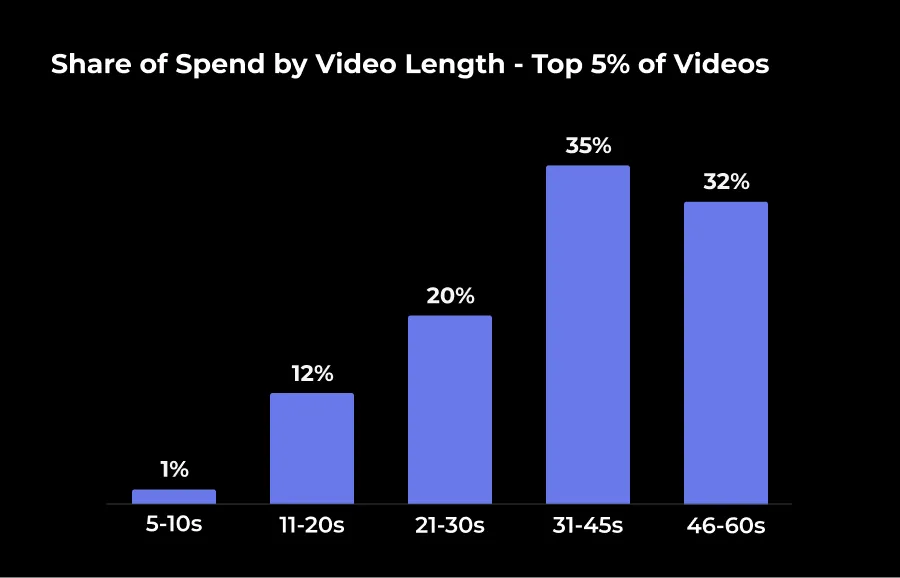Video best practices
このコンテンツはまだ日本語訳がありません。
To scale on the platform it is critical that you consistently test a high volume of creatives. AppLovin recommends that you upload as many 9×16 portrait videos as possible, on a regular basis, to help optimize your campaign performance.
You do not need to pause creatives. Axon’s optimizer automatically reduces spend on creatives that don’t perform. If you manually pause creatives, this may affect the creative’s opportunity to select the best ad for each impression.
Video length
AppLovin analyzed the top 5% of videos on its platform and found that the median length of video was 37 seconds. Advertisers should test videos of all lengths, with a focus on videos longer than 30 seconds.

Video strategies
AppLovin analyzed performance across top spending video ads, and identified recurring creative patterns that consistently drive stronger scale of spend across verticals. While creative testing remains a continuous, iterative process, the following approaches offer a good starting point for ideas to test on the platform.
Add captions to maximize engagement
Most mobile gamers have sound off by default, which makes captions critical. Subtitles not only improve accessibility but also boost performance significantly. AppLovin found that 95% of top spending videos it reviewed had prominent captions.
Wayfair’s Shoe Storage ad saw a significant drop in eCPP after captions were added:
Additional examples of effective captioning styles:
Highlight promotions and time-limited offers
Promotional offers are one of the most common and effective tactics among top-performing ads. In AppLovin’s review, approximately 40% of top videos featured some kind of promotion—whether it was a percentage or dollar discount, a BOGO-style offer, or a free item or service included with purchase.
Common offers include 10–40% off codes, free shipping, and free items with a first purchase. For example, several ads introduce “10% off code APP10” right at the hook, or promote “X free items with your order” or “buy 2 and get 1 free” as a closing incentive.
Urgency messaging is also widely used, with phrases like “Sale ending soon,” and “Get yours before they sell out” helping to drive faster decisions.
Appeal to specific audiences
Top advertisers successfully use creative visuals and messaging to speak directly to specific audiences. AppLovin found that about 30% of top ads explicitly define a group for whom the product might be relevant, with examples like:
- “As empty nesters…”
- “As a new college grad with a budget…”
- “My husband is in his 30 s and couldn’t find the right…”
- “Is it possible to get a flat stomach after 50?”
The vast majority of top-performing videos use a UGC-style format, either featuring a single person’s testimonial or cycling through clips of multiple people sharing positive reviews. Many advertisers with greater spend have a portfolio of ads that appeal to multiple specific demographic audiences.
Add social validation and viral momentum
Top advertisers tend to incorporate social proof into their videos to give viewers confidence to make a purchase. AppLovin found that 24% of top videos include social validation, using techniques like:
- Referencing the number of positive reviews (“That’s why over 100,000 women…”)
- Mentioning that the product went viral (“I finally got my hands on the viral…”)
- Suggesting that the product may sell out (“This frame is selling out like crazy…”)
Open with provocative UGC hooks
Many effective videos open with a provocative statement about a personal experience. These UGC hooks create open loops or questions that drive the viewer to keep watching for answers, rather than ignore an advertising message. In AppLovin’s review, about 15% of top videos use this type of hook.
Sometimes the hook is “criticism” about the product that flips into praise as the video proceeds. Other times, it’s a real problem the person used to have that the product helped solve. These hooks tend to perform well in structured formats such as “3 reasons why.”
Examples of provocative UGC hooks include:
- “Never buy the Nectar Foundation & Mattress bundle!”
- “It was a pity to spend money on this…”
- “I struggled with dry skin for years…”